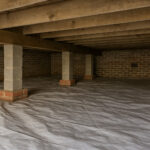If you or your family members suffer from year-round allergy symptoms, your home’s humidity level may be playing a bigger role than you think. High humidity levels allow mold spores, dust mites, and bacteria to flourish—turning a cozy basement or living room into a breeding ground for discomfort.
The good news? The best dehumidifier for allergies can transform your indoor air quality by reducing excess moisture and helping maintain a healthy environment. In this detailed homeowner guide, you’ll learn how dehumidifiers work, what features truly matter, which models stand out, and how to clean a dehumidifier so it keeps delivering clean, dry air for years to come.
Understanding the Link Between Humidity and Allergies
Humidity refers to the amount of moisture in the air. While some humidity is necessary for comfort, excessive humidity—anything above 55% relative humidity—creates ideal conditions for growth of mold, house dust mites, and pet dander accumulation.
When that happens, you might notice:
- Nasal passages feeling congested or irritated
- Unpleasant odors in damp basements or closets
- Condensation on windows and walls
- Increased dust buildup and particulate matter in the air
This combination leads to allergic reactions and long-term potential damage to your building structure. Balancing humidity between 30%–50% creates drier air, discouraging allergens while protecting your personal residence and important documents from mold stains or warping.
How a Dehumidifier Improves Indoor Air Quality
A dehumidifier pulls warm air into its system and cools it until water vapor condenses. The moisture collects in a water tank, leaving behind dry air that’s pushed back into your indoor spaces.
The process reduces:
- Mold formation and mildew growth
- Odor problems caused by bacteria
- Proliferation of dust mites
- Infrastructure deterioration from rot or rust
When combined with air purifiers featuring HEPA filters or UV light, you can achieve the perfect blend of humidity control and clean air purification.
Types of Dehumidifiers: A Closer Look
Before buying, it’s worth understanding the three main types available. Each works best for different room sizes, humidity levels, and climate conditions.
| Type | Best For | Advantages | Example |
|---|---|---|---|
| Compressor Dehumidifier | Large rooms and high humidity levels | Efficient, powerful moisture removal | hOmeLabs 50-Pint Energy Star |
| Desiccant Dehumidifier | Cool, small spaces | Works in low room temperature, lightweight | Pro Breeze 10-Pint Desiccant |
| Thermo-Electric (Peltier) | Small spaces like bathrooms or closets | Quiet, low energy use, compact small size | Eva-Dry EDV-1100 Mini |
Top Picks: Best Dehumidifiers for Allergy Sufferers (2025)
After evaluating homeowner reviews, performance tests, and energy use, here are five units that deliver the best balance of moisture control, reliability, and value.
1. hOmeLabs 50-Pint Energy Star Dehumidifier
Best for: Large basements and open living spaces
Capacity: Up to 4,500 sq. ft.
Highlights: Continuous drain option, auto shut-off, adjustable fan speeds
This high-capacity model is our top pick for tackling excess moisture in large rooms. It quietly extracts up to 50 pints per day, maintaining an optimal level of humidity while conserving energy.
Why homeowners love it: The Energy Star certification ensures low energy use, and the intuitive display helps you monitor relative humidity at a glance. Great for allergy sufferers who want long-term reliability.
2. Frigidaire FFAD5033W1 Dehumidifier
Best for: Everyday household use in medium-to-large spaces
Highlights: Washable filter, digital controls, and front-loading water tank
The Frigidaire model earns praise for its easy maintenance and quiet operation. It removes 50 pints daily and automatically adjusts based on room humidity.
Allergy benefit: The washable HEPA-style filter helps trap pet dander, particulate matter, and dust—ideal for those with respiratory conditions.
Bonus tip: Use this unit in your living room or bedroom alongside an air purifier for maximum clean air comfort.
3. Midea Cube 35-Pint Smart Dehumidifier
Best for: Tech-savvy families and smaller models homes
Highlights: Wi-Fi control, modular small size, and app-based humidity alerts
Unlike traditional models, the Midea Cube offers smart features that automatically adjust settings when moisture levels change. Its nesting design saves storage space, while the continuous drain keeps you from emptying tanks daily.
Why it’s great: Excellent for smaller units, book collections, or important documents storage rooms where stable humidity prevents infrastructure preservation issues.
4. Honeywell TP70WKN Energy Star Dehumidifier
Best for: Large households and humid conditions
Capacity: 70 pints/day
Highlights: Washable filter, digital humidistat, sleek look
Honeywell’s reliable design provides steady humidity control in large spaces such as basements or living rooms. It features multiple fan speeds and an alert for replacement filters.
Health advantage: Maintains pleasant indoor air and prevents the formation of mold, while offering energy efficiency that supports long-term savings.
The 70 pints/day is currenty sold out, however the 32 pint option is avaiable: Honeywell TPFIT32WK Energy Star Dehumidifier
5. Pro Breeze 10-Pint Desiccant Dehumidifier
Best for: Cool climates, small rooms, or enclosed spaces
Highlights: Lightweight, quiet, and effective at low room temperature
This desiccant dehumidifier excels where compressor models struggle—like garages, attics, or damp basements in winter.
Why it’s perfect for allergy sufferers: Keeps much moisture out of personal residences even in cold air, reducing the proliferation of dust mites and maintaining a healthy indoor environment year-round.
Air Purifiers and Dehumidifiers: A Perfect Pair
While dehumidifiers control moisture levels, air purifiers handle airborne particles. Using both together gives allergy sufferers a complete defense system.
How They Complement Each Other
| Device | Function | Key Benefit |
|---|---|---|
| Dehumidifier | Removes water vapor to prevent mold growth | Controls humidity levels and stops allergens from breeding |
| Air Purifier | Captures dust, pet dander, pollutants, and particulate matter | Provides clean air and reduces respiratory irritation |
Pro Tip: Choose a good air purifier with a HEPA filter and optional UV light for added odor reduction and germ control. Together, they create a pleasant indoor air atmosphere that supports healthier breathing and allergy symptom relief.
How to Clean a Dehumidifier (Step-by-Step)
Even the best unit will struggle if it’s dirty. Cleaning your dehumidifier regularly prevents bacteria buildup, maintains efficiency, and prolongs lifespan.
1. Unplug and Disassemble
Always start by unplugging the unit. Remove the water tank, filter, and any detachable panels. Never attempt to clean while powered on.
2. Empty and Rinse the Tank
Pour out any standing water. Rinse with warm water and mild dish soap. For stubborn slime, add a bit of vinegar. Dry thoroughly to avoid new mold spores forming.
3. Sanitize the Reservoir
Fill the reservoir with one part white vinegar and one part water. Let it sit for 10 minutes. This natural disinfectant breaks down residue and prevents bacterial growth.
4. Clean or Replace Filters
Wash washable filters under running water. For replacement filters, follow the manufacturer’s schedule—usually every 3–6 months. Clean filters help maintain dry air and reduce unpleasant odors.
5. Vacuum the Coils and Grille
Use a soft brush or a vacuum attachment to remove dust and pet dander from coils. This ensures optimal airflow and keeps fan speeds consistent.
6. Reassemble and Run a Quick Test
Once dry, reassemble all parts and power the unit on its highest setting for 10 minutes. Check for smooth operation and no leaks.
Cleaning frequency: Every 2–4 weeks during humid seasons or whenever odor or performance declines.
Common Mistakes Homeowners Make
Avoid these pitfalls to keep your unit running efficiently:
- Neglecting filters: Dirty filters block airflow and promote mold growth.
- Ignoring room placement: Keep at least 6 inches from walls for proper circulation.
- Running nonstop: Overuse can dry air excessively, causing discomfort.
- Using near humidifiers: Don’t pair with cool-mist humidifiers—they cancel each other out.
- Forgetting drainage: Standing water in the tank encourages mold formation.
Extra Tips for Maintaining a Healthy Indoor Environment
Dehumidifiers are one piece of the puzzle. Combine them with these strategies to improve indoor air quality across your home environment:
- Use air conditioners during summer to help regulate room temperature and humidity.
- Open windows briefly when outdoor humidity is low for fresh air exchange.
- Run exhaust fans in kitchens and bathrooms to prevent condensation reduction.
- Store book collections and important documents in rooms with moderate humidity.
- Keep pets groomed to reduce pet dander and hair that clogs filters.
- Inspect for leaks to preserve infrastructure and building structure.
Maintaining the right balance of temperature, moisture, and filtration supports your home’s infrastructure preservation and your family’s respiratory health.
Dehumidifier FAQs
Can a dehumidifier replace an air purifier?
Not exactly. While it improves air quality, it doesn’t capture dust or particulate matter. Pair it with an air purifier for best results.
Where should I place my dehumidifier?
Center it in the room with good airflow. Avoid corners or tight enclosed spaces.
What’s the ideal humidity for allergy sufferers?
Between 40–50% relative humidity—low enough to deter mold, high enough to prevent dry air discomfort.
Is it okay to run a dehumidifier all night?
Yes. Many have smart features and auto shut-offs to conserve energy and prevent over-drying.
Do desiccant models use more electricity?
No, they often use less at low temperatures, though compressor dehumidifiers remain more efficient in warm climates.
When to Replace Your Dehumidifier
Most units last 5–10 years. Replace yours if:
- It struggles to maintain optimal levels of humidity
- The water tank fills slower or leaks
- Strange noises persist even after cleaning
- You notice unpleasant odors that won’t go away
Modern models offer better energy use, smart features, and lower maintenance.
In Closing
For any allergy sufferer, investing in the best dehumidifier for allergies is a smart, long-term step toward comfort and wellness. These devices manage excess moisture, protect against mold prevention issues, and complement air purifiers for total clean air control.
By maintaining the right relative humidity, performing regular cleanings, and choosing a model suited for your living space, you’ll enjoy fewer allergy symptoms, better indoor air quality, and a home that feels fresher and healthier year-round.



